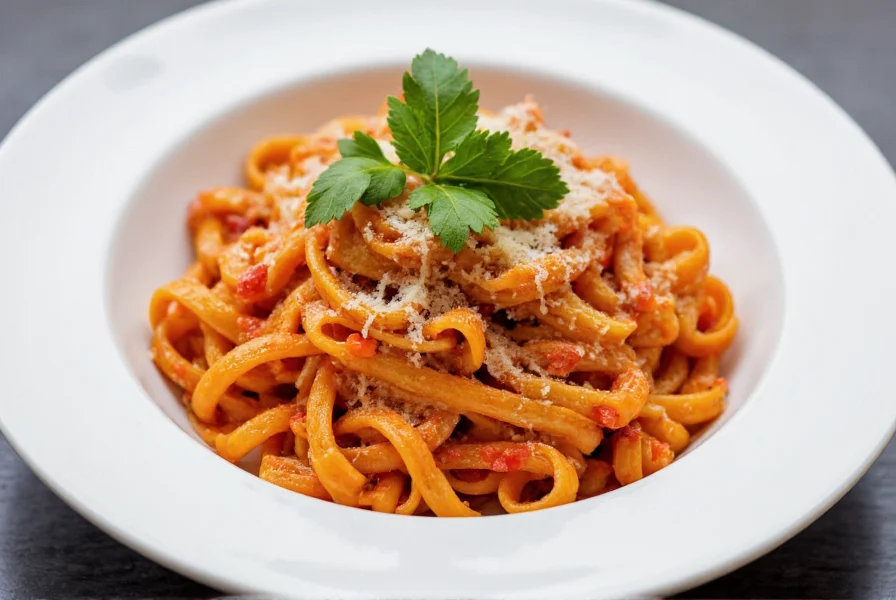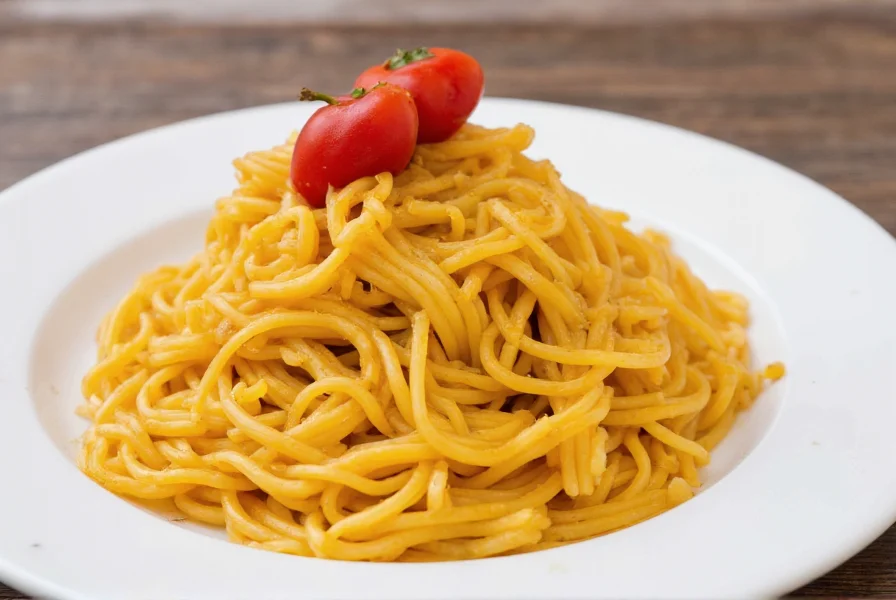Pepper pasta stands as one of Italy's most versatile and satisfying vegetable-based dishes, transforming humble ingredients into a restaurant-quality meal. This guide explores the authentic preparation methods, regional variations, and professional techniques that elevate this simple dish from ordinary to extraordinary.
What Exactly Is Pepper Pasta?
Pepper pasta, known as "pasta con peperoni" in Italian cuisine, features pasta combined with various types of peppers as the primary flavor component. Unlike American "pepperoni" which refers to cured meat, the Italian "peperoni" means peppers—specifically bell peppers. This dish showcases the natural sweetness of peppers balanced with garlic, olive oil, and quality Parmesan.
Authentic pepper pasta typically uses bell peppers, though creative variations incorporate roasted red peppers, spicy Calabrian peppers, or even sweet pimientos. The dish maintains its integrity through minimal ingredients and careful cooking techniques that preserve the peppers' vibrant color and crisp texture.

Choosing the Right Peppers for Your Pasta
The pepper selection dramatically impacts your dish's flavor profile. Understanding pepper varieties helps create the perfect pepper pasta experience:
| Pepper Type | Flavor Profile | Best Pasta Pairing | Cooking Tip |
|---|---|---|---|
| Bell Peppers (all colors) | Sweet, mild, vegetal | Penne, fusilli | Sear quickly over high heat to maintain crispness |
| Roasted Red Peppers | Smoky, sweet, complex | Linguine, spaghetti | Add at the end to preserve delicate flavor |
| Peperoncini | Spicy, tangy, vinegary | Short pasta shapes | Use sparingly for heat without overwhelming |
| Calabrian Peppers | Fiery, fruity, complex | Any pasta shape | Infuse oil first for even heat distribution |
Essential Ingredients for Authentic Pepper Pasta
Creating exceptional pepper pasta requires attention to ingredient quality. Professional chefs emphasize these components:
- Pasta: Bronze-die extruded pasta like De Cecco or Rummo holds sauce better. Penne, fusilli, or rigatoni work best for trapping pepper pieces.
- Peppers: Fresh, firm peppers with taut skin. Avoid peppers with wrinkles or soft spots.
- Olive Oil: Extra virgin with peppery finish (like Tuscan or Sicilian) adds complexity.
- Garlic: Fresh cloves, never pre-minced. One large clove per serving provides ideal flavor.
- Cheese: Parmigiano-Reggiano aged 24+ months, freshly grated.
- Finishing Touch: High-quality sea salt and freshly cracked black pepper.
Step-by-Step Perfect Pepper Pasta Recipe
Follow these professional techniques for restaurant-quality pepper pasta at home:
- Prepare peppers: Slice bell peppers into uniform 1/4-inch strips. Keep colors separate for visual appeal.
- Cook pasta: Boil in well-salted water (1.5 tablespoons salt per gallon) until al dente. Reserve 1 cup pasta water before draining.
- Sear peppers: Heat 3 tablespoons olive oil in large skillet over medium-high. Add peppers in single layer without crowding. Sear 3-4 minutes until edges char but peppers remain crisp.
- Build flavor base: Reduce heat to medium. Add minced garlic and red pepper flakes. Cook 30 seconds until fragrant but not browned.
- Combine elements: Add drained pasta to skillet with peppers. Toss vigorously while adding splashes of reserved pasta water to create emulsion.
- Finish properly: Remove from heat. Add grated Parmesan and additional olive oil. Toss until glossy sauce forms.
- Serve immediately: Plate in warmed bowls with extra cheese and freshly cracked black pepper.

Professional Tips for Elevating Your Pepper Pasta
Master chefs employ these techniques to transform simple pepper pasta into something extraordinary:
- Temperature control: Never add cold pasta to hot skillet. Let pasta rest 30 seconds after draining to prevent steaming.
- Emulsion science: The starch in pasta water binds oil and water. Add it gradually while tossing vigorously to create a silky sauce.
- Layered seasoning: Salt water, salt peppers during cooking, and finish with flaky sea salt for dimensional flavor.
- Cheese technique: Add cheese off-heat to prevent clumping. The residual heat melts it perfectly into the sauce.
- Texture contrast: Keep peppers slightly crisp for textural interest against tender pasta.
Delicious Variations to Explore
Once you've mastered the basic technique, experiment with these authentic variations:
- Creamy Pepper Pasta: Add 1/4 cup heavy cream during the final tossing stage for a richer sauce that still lets pepper flavor shine.
- Protein-Enhanced: Add grilled chicken, shrimp, or Italian sausage cooked separately to maintain pepper integrity.
- Roasted Pepper Version: Roast whole peppers over open flame until charred, then peel and slice for deeper flavor.
- Spicy Arrabbiata Style: Increase red pepper flakes and add a splash of tomato paste for a spicy kick.
- Summer Vegetable Medley: Incorporate zucchini, eggplant, and cherry tomatoes for a primavera-style dish.
Avoiding Common Pepper Pasta Mistakes
Even experienced home cooks make these frequent errors when preparing pepper pasta:
- Overcooking peppers: Mushy peppers ruin texture. Sear quickly over high heat to maintain crisp-tender quality.
- Adding cheese to boiling sauce: High heat causes cheese to clump. Always remove from heat before adding cheese.
- Using pre-grated cheese: Contains anti-caking agents that prevent proper melting. Grate fresh for best results.
- Skipping pasta water: Essential for creating the emulsion that binds sauce to pasta.
- Crowding the pan: Causes peppers to steam rather than sear. Cook in batches if necessary.
Serving Suggestions and Perfect Pairings
Complete your pepper pasta experience with these authentic Italian pairings:
- Wine Pairing: A medium-bodied Italian red like Chianti Classico or a crisp white like Vermentino complements the dish perfectly.
- Side Salad: Arugula with lemon vinaigrette provides refreshing contrast to the warm pasta.
- Bread Selection: Crusty Italian bread for soaking up any remaining sauce.
- Dinner Sequence: Serve as a primo (first course) followed by grilled protein for a traditional Italian meal structure.
Frequently Asked Questions
What's the best pasta shape for pepper pasta?
Penne, fusilli, and rigatoni work best for pepper pasta as their shapes trap pepper pieces and sauce. The ridges and hollow centers capture the flavorful oil and pepper bits, creating a more satisfying eating experience than smooth pastas like spaghetti.
Can I make pepper pasta ahead of time?
Pepper pasta is best served immediately after preparation. However, you can prepare components ahead: slice peppers and store in airtight container for 2 days, cook pasta water with salt ratio measured, and grate cheese fresh when needed. Reheating causes peppers to become mushy and pasta to overcook.
How do I prevent my pepper pasta from becoming watery?
To prevent watery pepper pasta, ensure peppers are properly seared (not steamed), use minimal pasta water (add gradually), and finish the dish off-heat. The starch in pasta water should emulsify with olive oil to create a glossy coating, not a watery sauce. Toss vigorously in the skillet until the sauce clings to the pasta.
What's the difference between pepper pasta and arrabbiata?
Pepper pasta focuses on bell peppers as the primary ingredient with minimal seasoning, while arrabbiata features tomatoes and significant red pepper flakes for heat. Traditional pepper pasta contains no tomatoes, highlighting the natural sweetness of peppers, whereas arrabbiata is a spicy tomato-based sauce. Both can incorporate red pepper flakes, but pepper pasta emphasizes vegetable flavor over heat.
Can I make a gluten-free version of pepper pasta?
Yes, use high-quality gluten-free pasta like Barilla or Jovial bronze-die extruded varieties. Cook according to package directions but check frequently as gluten-free pasta can go from al dente to overcooked quickly. Reserve extra pasta water as gluten-free pasta often requires more liquid to create the proper emulsion. The pepper preparation remains identical.











 浙公网安备
33010002000092号
浙公网安备
33010002000092号 浙B2-20120091-4
浙B2-20120091-4